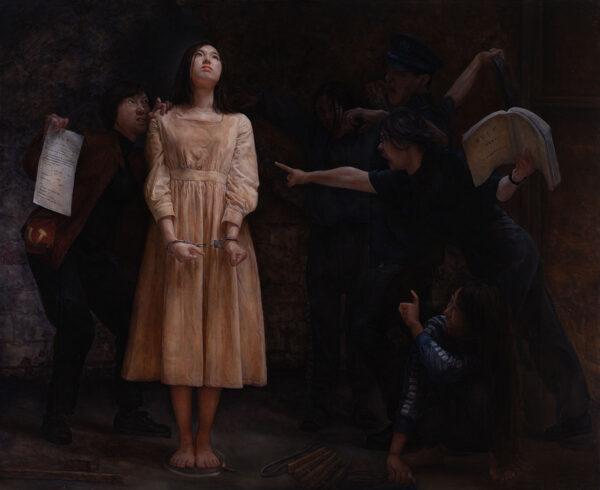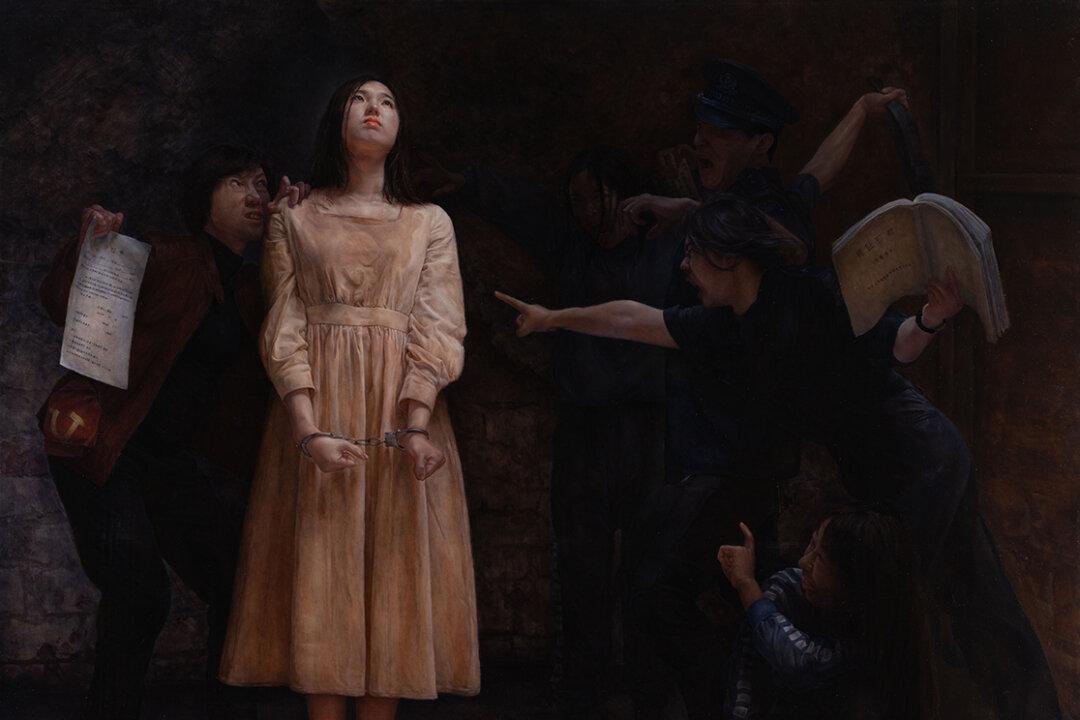When Chin-Chun Liu heard on the radio the story of the Beijing Women’s Labor Camp, she was deeply moved by the details. It was the story of Zhang Yijie, a woman who refused to give up her faith in the face of brainwashing and torture at the Chinese labor camp.

In a stunning, large-sized oil painting, Liu depicted Zhang Yijie’s story; the brave protagonist stands unmoved in the midst of brutal chaos, steadfast in her faith.
“In the [radio documentary], she was not allowed to sleep, she was mentally tortured, they read notes from her family members who blamed her, and she had to work in the labor camps,” Liu said. “But because of her faith, she does not hate—not even the people who treat her like this. Without such faith there is no way to survive such suffering and torture—I was very touched. I wanted to draw her story.”
Zhang Yijie is a practitioner of Falun Gong, also known as Falun Dafa. The spiritual practice was introduced to the public in 1992: it is a set of five meditative exercises and teaches the principles of truthfulness, compassion, and forbearance. By 1999, the number of adherents had grown to an estimated 70 to 100 million people in China. The Chinese Communist Party (CCP) grew uneasy at the idea of any faith spreading widely in the country—the communist nation still persecutes Christians, Tibetans, and Muslims today—and organized a crackdown.
Overnight, the CCP ordered that the practice be eradicated. People who persisted in practicing Falun Dafa would be arrested and sent to “re-education,” or brainwashing, labor camps.
Liu, from Taiwan, is a practitioner of Falun Dafa herself.
Composition of Contrasts
This is the first time Liu has worked on such a large painting.“It’s a bit of a breakthrough, artistically,” Liu said. The work took half a year to complete, with another one to two months to conceive of the design.
“The surrounding is very chaotic,” Liu said. “The shades are bright and dark, contrasting between cold and warm, reflecting the positive and negative figures, reflecting the fact that no matter how chaotic the external world is, what means these disruptive forces use, a person of steadfast faith is unmoved. There is no way to influence her.”
Liu explained the significance of the figures surrounding Zhang Yijie, who is depicted in bright colors and warm tones.
One person holds a note allegedly written by the woman’s family, blaming her for her own persecution because she would not renounce her faith and come home. Another figure holds the belt that whipped her, squatting on the ground and laughing at her. The figure holding the book is reading a story of real torture, ready to implement the techniques he’s learned on the woman—these are all details taken from reality.
Liu said that although the actual scene of persecution must not have played out like this, with a dynamic arrangement of bodies on opposing sides, these methods of torture were all things that happened to Zhang Yijie—and others. In a way, it is representative of not just Zhang Yijie’s story, but the persecution of Falun Dafa practitioners across communist China.
An Artistic Breakthrough
The process of creating this work—and of her journey as an artist in general—is one of spiritual and artistic breakthrough.Liu started learning art from an early age, though at the time it was just doodling and graffiti. From high school onward, she pursued a classical art education and studied for 10 years under the award-winning artist Li Yuan in Taiwan.
Classical realism, as Liu explains, is not just about the surface techniques; in other words, it’s not enough that the subjects depicted look real. Those are merely the most basic standards for a work of art.
“Classical art has more connotative requirements like balance, rhythm, and harmony,” Liu said. It is firmly an act of creation, and one that demands a long process of training in the style, on top of artistic vision.
When Liu achieves an artistic breakthrough, it is never without a spiritual breakthrough as well. “They are inseparable,” she said. “There must be improvement spiritually, for there to also be such a feeling in the painting.”
“Classical beauty is to be more refined, to express divinity,” Liu said. “Art comes from life, but should in a way be above life.”
Liu said her favorite painters are the giants of the neoclassical period, as well as the academic Bouguereau. He painted both simple peasants and glorious gods with finely honed skills.
“Some of his paintings are very sacred, they exude light, and a degree of refinement that feels very divine while the technique is very realistic,” Liu said. “You almost think you can feel the texture of the skin.”
“I feel that classical painters have a very strong visual sensibility, and ability of artistic expression,” Liu said. “Art is meant to touch people, and they all created ways to do so.”
“I hope that if someone sees the picture, they can be touched, moved, and feel something meaningful,” Liu said.






